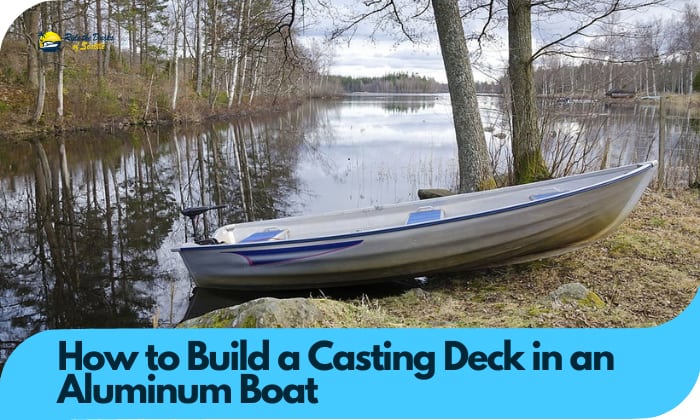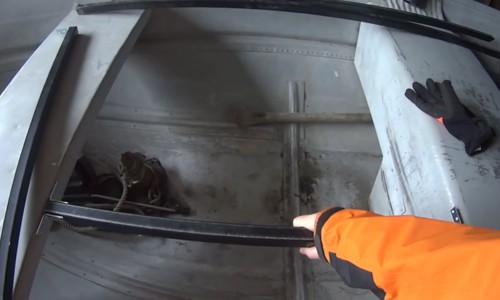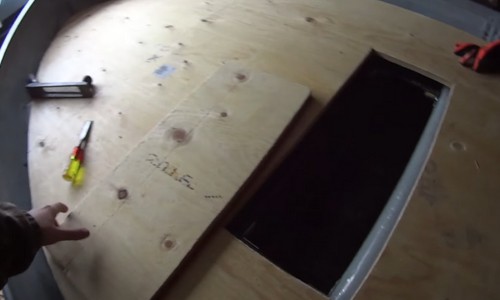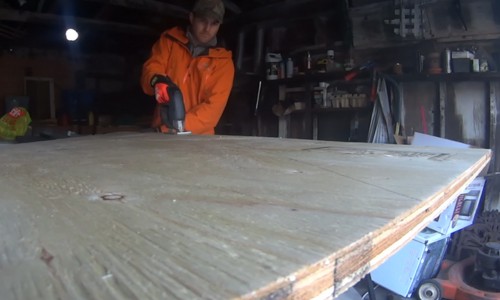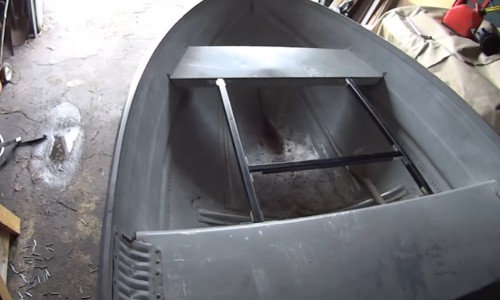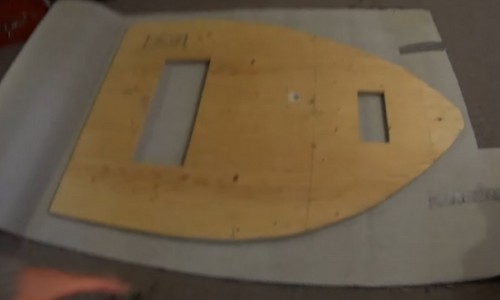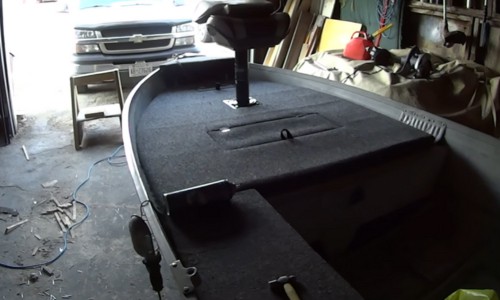Many are discovering the joys of fishing. And with aluminum boats becoming more practical and recreational fishing-centric, it won’t take long until everyone wants a dedicated platform to cast. You can get a head start if you know how to build a casting deck in an aluminum boat.
A casting deck gives you unrestricted access to fish-rich waters, allowing you to cast on-target and increase the chances of reeling in a prized catch. Don’t worry if your aluminum boat doesn’t have this platform. We’ll show you how to make a DIY casting deck.
Let’s start.
Table of Contents
- Step-by-Step to Build a Casting Deck in an Aluminum Boat
- What to Prepare
- Step 1. Measure the Aluminum Boat’s Deck Space for Casting.
- Step 2. Determine the Casting Deck’s Shape.
- Step 3. Cut the Aluminum Boat Casting Platform Material
- Step 4. Fabricate the Casting Deck Frame.
- Step 5. Prepare the Material and Set Up the Carpet
- Step 6. Install the Aluminum Boat Casting Deck and Related Accessories.
- Maintenance and Safety Considerations
- FAQs
- Conclusion
Step-by-Step to Build a Casting Deck in an Aluminum Boat
What to Prepare
Any casting deck material mustn’t detract from the aluminum boat’s lightweight characteristics. Hence, this project requires carefully considering resources for a nonslip, lightweight, sturdy, and reliable aluminum boat deck build. Here’s a tentative list of materials to prepare.
- Deck template
- One-piece ½” plywood
- Marine-grade carpet
- Pedestal seat
- Latch
- Wood studs or square-edged aluminum pipes
- 320-grit or 220-grit sandpapers
- Jigsaw
- Tape measure
- Wood sealant
- Heavy-duty, marine-grade glue
- Drill and bits
- Staple gun
- Adhesive tape
- Utility knife
- Screws
Here are the steps for making a reliable and sturdy homemade aluminum boat casting deck.
Step 1. Measure the Aluminum Boat’s Deck Space for Casting.
Aluminum boats don’t have fancy components like a center console to make deck measurements challenging. However, we recommend checking your watercraft’s dimensions to determine the best-fitting aluminum boat decking.
- Identify the watercraft’s widest section (right to left) and use a tape to measure said section. The result will be the deck’s width.
- Look at your aluminum boat and decide the casting deck’s limit. For example, most anglers use the boat’s second bracing (from the bow) as a reference point for building front deck platforms. You can observe the same technique if you wish for a rear (stern) casting deck.
- Measure the casting deck’s length by positioning the tape measure’s end at the bow and extending it to the desired point perpendicular to the first or second bracing. Ensure to measure only the aluminum boat’s interior space.
Step 2. Determine the Casting Deck’s Shape.
You have a few options for this step. The first and more convenient one is to look for online casting deck plans and ideas specific to your aluminum boat. You could save precious time determining the correct deck shape and measurements.
The second option (and more hands-on) is to determine the aluminum Jon boat casting deck shape yourself. Here’s how:
- Get several pieces of cardboard and lay each on the aluminum boat floor approximating the casting deck.
- Secure the cardboard edges with tape to create a single piece.
- Fold the cardboard edges along the boat’s sides to create a crease for cutting.
- Get your utility knife and cut out the excess cardboard edges to create an outline.
Pro Tip: You can start with smaller cardboard pieces and cut them out to follow the boat’s contours. Piece these cardboard segments like you would a jigsaw puzzle.
Step 3. Cut the Aluminum Boat Casting Platform Material
This step in the aluminum boat casting deck construction requires the template you created in Step 2.
- Get the plywood and place it on a workbench or table.
- Place the casting deck template over the plywood. You can secure the former with tape to prevent it from moving around. Then, use a marker to outline the template before removing it.
- Start cutting the plywood with a jigsaw following the aluminum casting platform outline. Cut about half an inch inside the outline to allow for marine carpet installation.
- Fit the casting deck cutout into the aluminum boat and make the necessary adjustments.
Pro Tip: Please use one-piece ½” plywood to ensure a sturdy and leak-resistant casting deck. Although using several board pieces work, there’s the risk of damaging the platform at the plywood joints.
Step 4. Fabricate the Casting Deck Frame.
You’re now ready to focus on the aluminum boat casting deck frame.
Two options are available: fixed and detachable. The latter is perfect for folks who want to retain their aluminum boat’s versatility. Meanwhile, a fixed aluminum boat deck framing is suitable for owners who demand a dedicated fishing vessel.
Note: detachable decks require wood studs, while fixed platforms require aluminum bracing.
Fixed (Aluminum pipe)
- Measure the length from the bow to just before the second bracing or right after the first brace.
- Determine the width adequate for casting deck support.
- Cut the pipe into sections and smoothen the edges with 320-grit sandpapers.
- Create an H-shaped frame by bolting or welding the aluminum pieces.
Detachable (Wood studs)
- Measure the aluminum boat’s inside dimensions.
- Cut the wood and smoothen the surfaces and edges with 220-grit sandpapers.
- Create a casting deck frame with wood by joining the pieces with screws or heavy-duty wood glue.
Pro Tip: Use Spruce for wood studs because it’s strong and lightweight.
Step 5. Prepare the Material and Set Up the Carpet
This step to making casting decks on aluminum boats requires adding a non-slip surface to the plywood casting deck before installing it to the frame.
- Apply wood treatment if you have a detachable casting deck. It’s worth noting that wood degrades with moisture exposure. A wood sealant, such as polyurethane, should ensure the deck frame’s longevity.
- Choose a marine-grade carpet to create a non-slip surface for the casting deck.
- Place the carpet wrong side up on an even surface.
- Lay the wooden casting deck on the carpet.
- Follow the casting deck’s outline with a marker, leaving sufficient allowance for folding the material into the decking. Alternatively, you can cut out the carpet without outlining.
- Cut the marine-grade carpet and fold it to conform to the casting deck.
- Pull the carpet so that it’s sufficiently stretched, then staple the carpet to the casting deck’s sides and bottom. You can also press the carpet firmly if you don’t have a staple gun.
Pro Tip: Check the carpet is taut without creases.
Step 6. Install the Aluminum Boat Casting Deck and Related Accessories.
Evaluate your work before fixing everything to the aluminum boat, which is unnecessary if you have a detachable casting deck. Once satisfied, you can start installing the casting platform into the watercraft.
- Grab the carpet-covered casting deck and place it over the frame, ensuring a correct fit.
- If you have a fixed aluminum frame, bolt the deck to the supporting skeleton.
You can forego the above procedures when installing a pedestal seat.
- Mark the pedestal seat’s mounting holes on the casting deck.
- Drill holes into the casting deck.
- Bolt the pedestal seat into the casting deck.
After setting up the pedestal seat, you can install the casting deck into the frame.
Pro Tip: Choose a comfortable but space-efficient swivel seat to make your fishing adventures worthwhile
Many boaters find the following video advantageous in helping them build a lightweight casting deck for their aluminum boats.
Maintenance and Safety Considerations
Building a casting deck in an aluminum boat requires observing the following maintenance and safety considerations.
- Treat the wood with an appropriate marine-grade sealant before installation to protect the material against water-related damage. If possible, opt for a formula with a low VOC level to avoid possible health hazards.
- Wear protective gear, especially when welding aluminum parts or cutting plywood or spruce. Wood chips and other particles can enter the eyes, splinters can scratch the skin, and dust can irritate the throat and lungs.
- Store the detachable casting deck in a dry place when not fishing to improve its longevity.
- Aluminum doesn’t require fussy maintenance except for an occasional wipe of the surfaces.
- Use a mixture of 1-gallon water and 40 ounces of vinegar to clean the marine carpet with a medium-bristled scrubbing brush. Rinse the carpet thoroughly.
- Blot-dry any stains on the carpet as soon as you notice them. Otherwise, apply an appropriate stain remover.
- Remove fish blood drippings and other stubborn stains with mild dishwashing soap and cold water.
- Check the marine carpet for offensive odors and dust the soiled area with baking soda. You can moisten the spot to allow the baking soda to adhere to the carpet and remove the odor. Leave it overnight before vacuuming the baking soda from the carpet.
FAQs
What’s a Boat’s Casting Deck?
Aluminum boats have a slightly slippery surface, making fishing quite risky. A casting deck addresses this issue by providing anglers with a non-skid platform, allowing them to cast and reel in their catch without risking falling into the water.
Additionally, casting decks offer boaters a vantage point for examining the fishing grounds and surroundings.
What’s the Best Material for an Aluminum Boat Casting Deck?
An aluminum frame remains the best solution for an aluminum boat casting deck because it doesn’t detract from the watercraft’s lightweight characteristics. Unfortunately, cutting, framing, and securing aluminum pieces might not be for the novice boat owner.
Wood is the next-best choice, although you might want to research lightweight but strong wood species. My go-to recommendations are Burmese teak, mahogany, and marine-grade plywood. Pretreating the wood with sealants is also crucial to improve its moisture resistance.
Conclusion
You now know how to build a casting deck in an aluminum boat. The steps outlined are straightforward and convenient, allowing you to complete the project in an hour or two. The most crucial step in this project is ensuring the correct deck measurements to guarantee stability.
We recommend a detachable casting deck because it retains the aluminum boat’s versatility. You can use the watercraft for other purposes, allowing your family to enjoy boating besides fishing.

Ten years of enjoying countless trips on boats never made me love them any less! So I am here to put all those experiences into good use for other boaters who want to have a safe and fun trip with their friends and families.

